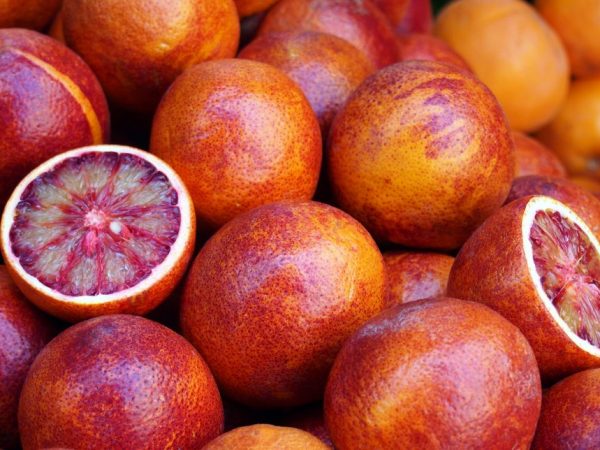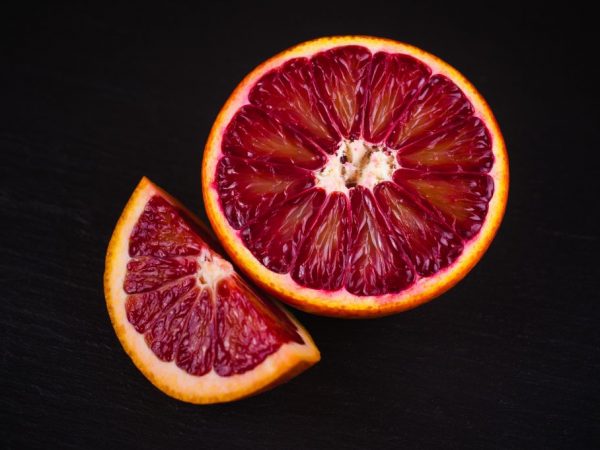Bloody sicilian orange
Sicilian orange for its unusual bright red color of the pulp is nicknamed bloody. It grows on the island of Sicily and has several varietal varieties.

Bloody sicilian orange
Botanical characteristic
The Sicilian orange, along with other citrus fruits, belongs to the rue family. It is an evergreen plant with a pyramidal crown formed by oval foliage with a glossy shiny surface. It blooms with white fragrant buds. Under natural conditions, an orange tree grows up to 6 m in length. The flowering frequency is several times a year, the flowering and fruiting stages sometimes overlap.
Fruits are often oval in shape, with a slightly ribbed surface, weight - up to 250 g, the peel is easily peeled off. The pulp is coarse and juicy, the taste depends on the species.
The bloody color of the red Sicilian orange is associated with the specific microclimate of the plant's growth and is due to large differences in day and night temperatures due to the impact of a stratovolcano located on the east coast of Sicily.
In contrast to the classic varieties of citrus, which chemically contain only the natural yellow-orange dye carotene, the Sicilian orange contains anthocyanin, which gives the fruit a characteristic red hue at the stage of full biological maturity.
Depending on the varietal varieties, the pulp of the Sicilian orange is:
- blood red
- burgundy,
- orange.
The peel is brown or dark orange with a red tint.
Area
Initially, the fruit was cultivated only in Sicily, which is why it got that name. The geography of distribution is limited to areas with dry climatic conditions, where there is a significant difference between daytime and nighttime temperature indicators in the autumn-winter season.
Today, bloody citrus fruits are also grown in Spain and Morocco, the American states of California and Florida.
Varieties
Sicilian citrus has several varieties.
Moro's Bloody Orange

The fruits have a raspberry flavor
The species was one of the first to be grown commercially. Fruits are small in size, 5-8 cm in diameter, weighing 120-180 g. Among all species, the most colored and bloody, the color of the pulp is dark, up to black in the upper part of the fruit. Taste and aroma characteristics are higher than those of other varieties.
In its composition, Moro has a large number of anthocyanins, therefore the most pigmented. By the stage of full maturity, the peel is covered with red-violet specks. The taste is sweet with raspberry notes.
Refers to early maturing species.
Sanguinello orange
The red Sicilian orange Sanguinello is close to Moro in varietal characteristics. It has a short ripening period: in February-March. Fruits are medium-sized, elongated or rounded, with a yellow-red peel, less pigmented flesh, orange, with bloody blotches.It is considered the most delicate in taste with a lower content of acid and anthocyanins. The variety belongs to the late ripening, ripens among the last species of bloody citrus fruits. Growing places - Catania and Syracuse.
Sanguinello has a nutmeg subspecies, which is distinguished by larger fruits and less color intensity, taste with pronounced nutmeg notes.
Tarocco orange
The most widespread varietal variety of the Sicilian orange - Tarocco - is especially popular in Italy. It is the product of the Sanguinello mutation. Fruits are round, weighing 150-200 g. The pulp is orange-red, sweet, juicy, with berry notes. The peel is thin, sometimes it has a reddish tint. It is allocated with a high content of ascorbic acid. Fruits are medium in size. The number of seeds is minimal or absent altogether.
Conclusion
Sicilian red orange is a bloody citrus variety. It has a high content of anthocyanins, which gives the fruit a specific color. It has several varieties.
Areas with significant temperature fluctuations during the day and at night are suitable for growing fruit.


